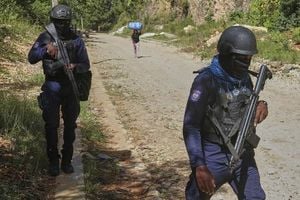Recently, British Columbia has drawn attention after one of its teenagers contracted H5N1, the avian flu virus known for its potential severity. This incident raises eyebrows for many within the healthcare community, not only because of the virus's nature but also due to the mystery surrounding the transmission of the disease. The case, confirmed to be the sole one reported within the province, has health officials working diligently to understand how this has happened and what risks, if any, it presents to the broader public.
B.C. Provincial Health Officer, Dr. Bonnie Henry, reported on November 26, 2024, stating unequivocally, "The teenager infected with avian flu remains the sole case in B.C. We are still searching for clarity on how the virus was contracted." This lack of clarity has sent alarm bells ringing among parents, health authorities, and education officials.
Keeping the public informed, experts caution against panic. The risk of spreading the virus to others appears to have been assessed low. Following the teenager's diagnosis, health officials conducted thorough evaluations. They ruled out various transmission scenarios, including contact with potentially infected birds or environments.
The interest doesn’t just lie with the existing case but rather the broader specter of H5N1 itself. Known primarily for its presence among domestic and wild birds, H5N1 can occasionally leap to humans, mainly through direct contact. Symptoms can range from mild illness to severe respiratory distress, even leading to death. This reality makes the recent case even more salient.
Experts from the field of infectious diseases have noted, "With avian flu, the concern is not just about direct transmission but also the possibility of mutations. If this virus evolves to spread between humans, it could create significant public health challenges." That concern is particularly heightened now, especially during the seasons when flu cases typically surge.
The current situation is not isolated to British Columbia alone; reports from different parts of North America have detailed avian influenza outbreaks. Just within the last few months, nearly 7 million birds were culled across B.C. due to the observed outbreaks, which necessitated strict biosecurity measures. Such actions highlight the continuous threat posed by H5N1 to poultry farmers and potentially, indirectly, to human health.
It’s important to recognize the importance of surveillance and monitoring. Just days before this incident, health officials had assured the public there were no active human cases of H5N1 within British Columbia. Therefore, the unexpected confirmation of this case emphasizes the unpredictable nature of zoonotic diseases, those transmissible from animals to humans.
Responding to public sentiment, Dr. Henry reaffirmed, "We have protocols and plans to deal with infectious diseases to mitigate any potential health risks. The community’s health is a priority, and we want to keep it safe." Health officials encourage cautious behavior, advising citizens to practice good hygiene, especially around areas known to harbor wildlife.
This situation has sparked debates about appropriate responses to avian flu threats and the necessity of heightened public health measures. Some community leaders are advocating for more rigorous guidelines when nearing wildlife areas or engaging with domestic birds. Schools have heightened awareness among kids about the disease, discussing safe interactions with animals.
Looking at the bigger picture, monitoring wild bird populations becomes increasingly imperative. Wild birds often serve as reservoirs of various strains of bird flu, including the potent H5N1. Frequent outbreaks point to the reality of wild bird migration patterns harboring potential risks for avian influenza recurrence each season.
Major agricultural stakeholders are watching the situation closely, too. The impact on the poultry market due to culling has ramifications for producers within the province and beyond, affecting supply chains and prices. To counter these worries, the sector has bolstered its efforts to uphold biosecurity measures to shield birds from potential infections.
Education plays another central role. Health authorities have ramped up their initiatives to inform agricultural workers about signs of avian flu, encouraging immediate reporting of findings to local vet services or animal health inspectors. Creating more awareness on preventing farmer exposure to the disease is now deemed pivotal to keeping the potential spread at bay.
It remains to be seen what the ultimate path will be for the infected teenager, who, according to official statements, is expected to recover, though they still remain critically ill. This case must be viewed as part of a larger narrative—one around public health, the intersection with wildlife, and what steps communities must take to guarantee safety from zoonotic threats like avian influenza.
Meanwhile, the public anxiously awaits more updates from health officials, hoping for both clarity on transmission and reassurance concerning the safety of their communities. It's clear the response at all levels will be measured and reflective, emphasizing the need for vigilance concerning health matters. The situation discusses not just the teenager's recovery but the broader framework upon which public health stands and the interconnectedness of wildlife health with human health.



